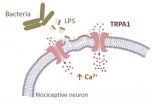(Press-News.org) Components in the outer wall of bacteria directly activate pain sensors, triggering immediate pain and inflammatory responses. This finding by a multinational team of researchers led by Professor Karel Talavera (KU Leuven, Belgium) and Professor Félix Viana (Institute of Neuroscience, Spain) sheds new light on pain associated with bacterial infections and reveals a new target for drugs designed to treat them.
Bacterial infections are a global health problem and their treatment remains a major challenge to modern medicine. Infections of Gram-negative bacteria, in particular, are a major cause of human diseases, such as pneumonia, meningitis, gastroenteritis and gonorrhea.
Part of Gram-negative bacteria's danger lies in certain disease-causing components in the bacteria's outer wall. The most significant, say the researchers, is lipopolysaccharide (LPS). In bacterial infections, LPS fragments from damaged bits of the bacterial walls are released locally, triggering an immune response.
When they come in contact with specialised TLR4 receptors at the surface of 'sentinel' immune cells, chemicals are released that recruit other immune cells, inducing swelling, tissue injury and eventual lyses and clearance of the bacteria.
But our immune system is unable to respond quickly enough to the presence of LPS, and fast reactions to this molecule, such as acute pain, inflammation and low blood pressure, remained unexplained until now.
The study, published in the 20 January issue of Nature Communications, uncovers, on the molecular level, how LPS causes these symptoms. The researchers found that LPS insert in the membrane surrounding sensory nerve endings, inducing a mechanical deformation that is then sensed by TRPA1 proteins. This leads to activation of TRPA1 within a matter of seconds, the influx of positively-charged ions into the nerves and the firing of electric signals that are interpreted as pain by our central nervous system.
In addition, the influx of calcium ions through TRPA1 induces the release of factors that produce dilation of the blood vessels and tissue inflammation.
The study is the culmination of a five-year probe by lead author Victor M. Meseguer (UC Berkeley) that started in a dentist's office. Inquiring into the cause of his toothache, he was told it was a bacterial infection but that the underlying molecular mechanisms were not yet known. Today, he and his co-authors are able to show that his tooth pain was caused by bacterial LPS targeting TRPA1.
TRPA1 proteins are already known to be a detector of multiple harmful compounds contained in smoke, mustard, wasabi and tobacco. We can now add bacterial LPS to that list, say the researchers.
"The identification of TRPA1 as a molecular determinant of direct LPS effects on pain-sensing neurons offers new insights into the pathogenesis of pain and neurovascular responses during bacterial infections and opens novel avenues for their treatment," said senior author Karel Talavera.
INFORMATION: END
New pain target for bacterial infections
2014-02-10
ELSE PRESS RELEASES FROM THIS DATE:
Mechanism elucidated: How smell perception influences food intake
2014-02-10
In animals, as in humans, hunger mechanisms are known to stimulate food intake. Hunger triggers a set of mechanisms that encourage feeding, for example by increasing sensory perceptions such as the sense of smell. The researchers have now succeeded in revealing what links hunger and increased smell perception in the brain, and the resulting urge to eat.
The researchers have discovered how this mechanism is initiated in the endocannabinoid system in mice. This system interconnects receptors located in the brain and involved in different sensations such as euphoria, anxiety, ...
University clinical pharmacologist researching chronic lead intoxication in goats
2014-02-10
MANHATTAN, Kan. -- The Nile is a river in Egypt. Sometimes that river is polluted with industrial waste, such as lead, which can cause detrimental effects on local sheep and goats via the water supply.
Kansas State University's Ronette Gehring is an associate professor of clinical pharmacology in the of anatomy and physiology department of the university's College of Veterinary Medicine. She has joined a team of researchers from Egypt, Jordan and the United States in evaluating the effect of chronic lead intoxication in goats. In December 2013, the researchers published ...
Report calls for abolition of fixed retirement age
2014-02-10
A report led by a professor at the University of Southampton recommends the worldwide removal of the fixed or default retirement age (DRA).
Professor Yehuda Baruch from the Southampton Management School, in collaboration with Dr Susan Sayce from the University of East Anglia and Professor Andros Gregoriou from the University of Hull, has found that, on a global scale, current pension systems are unsustainable.
Professor Baruch comments: "We have a global problem with funding pensions, which assume people will retire around their mid-60s. Young people are tending to ...
Study finds 3-fold increase in pregnancy among young girls with mental illness
2014-02-10
TORONTO, February 10, 2014 – Young girls with mental illness are three times more likely to become teenage parents than those without a major mental illness, according to a first-of-its-kind study by researchers at the Institute for Clinical Evaluative Sciences (ICES) and Women's College Hospital.
The study, published today in the journal Pediatrics, is the first to examine trends in fertility rates among girls with mental illness.
"Research tells us that young girls are at high risk of pregnancy complications, including preterm birth, poor fetal growth and postpartum ...
Drifting herbicides produce uncertain effects
2014-02-10
Farmers should take extra precautions so drifting herbicides do not create unintended consequences on neighboring fields and farms, according to agricultural researchers.
The researchers found a range of effects -- positive, neutral and negative -- when they sprayed the herbicide dicamba on old fields -- ones that are no longer used for cultivation -- and on field edges, according to J. Franklin Egan, research ecologist, USDA-Agricultural Research Service. He said the effects should be similar for a related compound, 2,4-D.
"The general consensus is that the effects ...
Young, unvaccinated adults account for severest flu cases
2014-02-10
DURHAM, N.C. – A snapshot of patients who required care at Duke University Hospital during this year's flu season shows that those who had not been vaccinated had severe cases and needed the most intensive treatment.
In an analysis of the first 55 patients treated for flu at the academic medical center from November 2013 through Jan. 8, 2014, Duke Medicine researchers found that only two of the 22 patients who required intensive care had been vaccinated prior to getting sick.
The findings were published online in Monday, Feb. 10, 2014, in the American Journal of Respiratory ...
Researchers discover immune signature that predicts poor outcome in influenza patients
2014-02-10
(Memphis, Tenn. – February 10, 2014) St. Jude Children's Research Hospital scientists have identified a signature immune response that might help doctors identify which newly diagnosed influenza patients are most likely to develop severe symptoms and suffer poor outcomes. The findings also help explain why infants and toddlers are at elevated risk for flu complications. The research appears in the upcoming issue of the American Journal of Respiratory and Critical Care Medicine.
The discovery came after investigators tracked flu infections for 28 days in 84 individuals ...
How do polar bears stay warm? Research finds an answer in their genes
2014-02-10
BUFFALO, N.Y. — In the winter, brown and black bears go into hibernation to conserve energy and keep warm.
But things are different for their Arctic relative, the polar bear. Within this high-latitude species, only pregnant females den up for the colder months.
So how do the rest survive the extreme Arctic winters?
New research points to one potential answer: genetic adaptations related to the production of nitric oxide, a compound that cells use to help convert nutrients from food into energy or heat.
In a new study, a team led by the University at Buffalo reports ...
Experimental care program keeps people with dementia at home longer, study shows
2014-02-10
An 18-month pilot program that brought resources and counselors to elderly Baltimore residents with dementia and other memory disorders significantly increased the length of time they lived successfully at home, according to Johns Hopkins researchers. Staying at home was a clear preference for most of those who participated in the study.
"The project demonstrated that we were able to help such people age in place without sacrificing their quality of life," says study leader Quincy Miles Samus, Ph.D., an assistant professor of psychiatry and behavioral sciences at the ...
Research reveals the give and take of urban temperature mitigating technologies
2014-02-10
TEMPE, Ariz. – Life in a warming world is going to require human ingenuity to adapt to the new realities of Earth. Greenhouse-gas induced warming and megapolitan expansion are both significant drivers of our warming planet. Researchers are now assessing adaptation technologies that could help us acclimate to these changing realities.
But how well these adaptation technologies – such as cool roofs, green roofs and hybrids of the two – perform year round and how this performance varies with place remains uncertain.
Now a team of researchers, led by Matei Georgescu, ...





